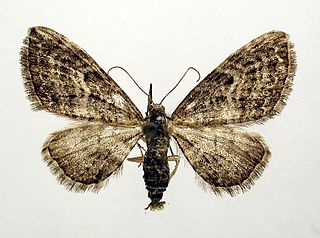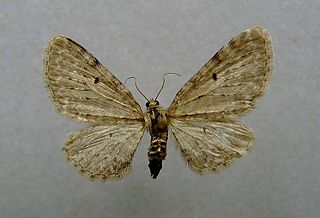
Eupithecia is the largest genus of moths of the family Geometridae, and the namesake and type genus of tribe Eupitheciini. Species in the genus are, like those of other genera in the tribe, commonly known as pugs. The genus is highly speciose, with over 1400 species, and members of the genus are present in most of the world with exception of Australasia. Roughly a quarter of described Eupithecia species occur in the Neotropical realm, where they have an especially high species diversity in the montane rain forests of the Andes. The genus includes a few agricultural pest species, such as the currant pug moth, Eupithecia assimilata, which is a pest on hops, and the cloaked pug moth, Eupithecia abietaria, which is a cone pest in spruce seed orchards.

The lime-speck pug is a moth of the family Geometridae. It is a common species throughout the Palearctic region, the Near East and North Africa.

The juniper pug or juniper looper is a moth of the family Geometridae. The species was first described by Michael Denis and Ignaz Schiffermüller in 1775. It is found throughout the Palearctic and in the Nearctic.

The larch pug is a moth of the family Geometridae. The species can be found in Europe, the Ural Mountains, West and Central Siberia, the Altai Mountains, Transbaikalia, Yakutia, the Far East, Mongolia, Korea, Japan and in North America, from Yukon and Newfoundland to New York and Arizona.

The cloaked pug is a moth of the family Geometridae. The species was first described by Johann August Ephraim Goeze in 1781 and it can be found in Europe and to the east in Siberia and Japan.

Eupithecia tripunctaria, the white-spotted pug, is a moth of the family Geometridae. The species can be found from Europe to Korea and Japan and in North America.

Eupithecia jezonica is a moth in the family Geometridae. It is found in Asia, including India and Nepal. It has also been recorded from Kazakhstan, the Russian Far East and Korea, Japan and Taiwan.

Eupithecia veratraria is a moth of the family Geometridae first described by Gottlieb August Wilhelm Herrich-Schäffer in 1848. It is found from the mountainous areas of Europe and Asia up to Japan.

Eupithecia quadripunctata is a moth in the family Geometridae. It is found in India, Pakistan, Nepal, Russia, China, Taiwan, Korea, Japan and northern Thailand.
Eupithecia subtacincta is a moth in the family Geometridae. It is found in the Himalaya, from Jammu and Kashmir through China to the Russian Far East, Korea and Japan. It is also found from south-east Asia to Borneo.
Eupithecia tenuisquama is a moth in the family Geometridae. It is a widespread species, ranging from the Himalaya to Japan.
Eupithecia amplexata is a moth in the family Geometridae. It is found in China, Russia and Japan.
Eupithecia subbreviata is a moth in the family Geometridae. It is found in Russia (Amur), Japan and Korea.
Eupithecia zibellinata is a moth in the family Geometridae. It is found in Russia (Amur) and Japan.

Eupithecia mandschurica is a moth in the family Geometridae. It is found in Russia (Amur) and Japan.
Eupithecia emanata is a moth in the family Geometridae. It is found in the Russian Far East, on the Kuriles and in Japan.
Eupithecia tantilloides is a moth in the family Geometridae first described by Hiroshi Inoue in 1958. It is found on the Kuriles and in Japan.
Eupithecia kurilensis is a moth in the family Geometridae. It is found on the Kamchatka Peninsula and the Kuriles and in Japan.
Eupithecia nagaii is a moth in the family Geometridae. It is found in Japan.
Eupithecia subfumosa is a moth in the family Geometridae. It is found in Japan.









